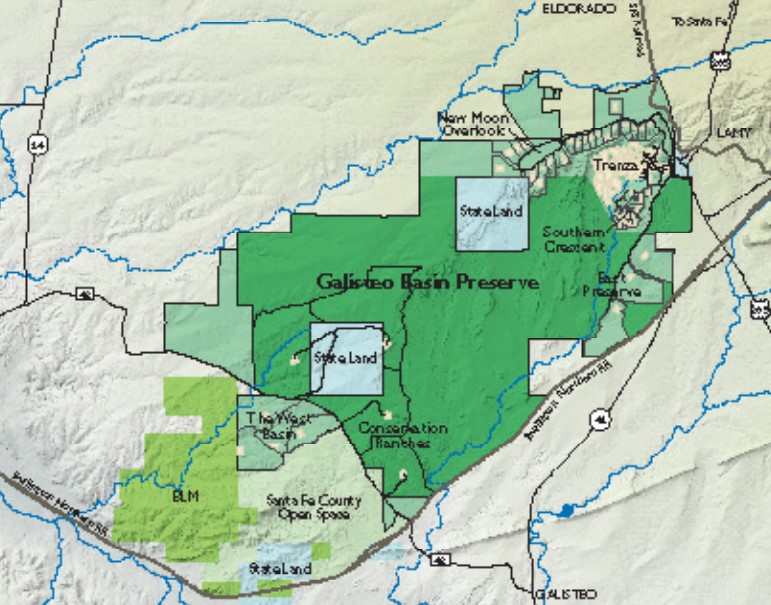
The Galisteo Basin Preserve mixes private and public conservation land in one development.
Image: Computer Terrain Mapping and Site Workshop/ Commonweal Conservancy


left image: Map of the limited development strategy Image: Computer Terrain Mapping and Site Workshop/Commonweal Conservancy
right image: The yellow area shows how the Galisteo Basin Preserve would have been overrun by development without a conservation plan. Image: Computer Terrain Mapping and Site Workshop/Commonweal ConservancyMapping and Site Workshop/Commonweal Conservancy
| Developer | Commonweal Conservancy |
| Date | 2003-23 |
| Location | Galisteo Basin Preserve, Santa Fe, New Mexico, USA |
| Financing | Los Alamos National Bank |
| Conservation Area | 13 076 acres |
| Total Site Area | 13 522 acres |
| Featured Project | Milder Residence |
| Design Firms | Signer Harris Architects, WoodMetalConcrete |
| Contractor | Fred and JJ Milder |
| Unit Cost | $2 million USD |
| Unit Type | 4-bedroom house |
| Unit Area | 464 sq m/5000 sq ft |
The Commonweal Conservancy was founded in 2003 to provide an alternative model for development of open spaces and sensitive landscapes in the American Southwest. Founder Ted Harrison drew on 20 years of experience with the national nonprofit Trust for Public Land to produce stringent guidelines for developing historic ranching lands and protecting the region from unchecked sprawl. Though it seems counterintuitive to protect open space by developing a part of it, Harrison believes sensitive development can do this.
Typically, conservancy groups are at odds with property developers, but in the case of Galisteo Basin Reserve, the price tag on the luxury homes funds a land trust that will permanently protect about 90 percent of the 13 522-acre former ranch near Santa Fe, New Mexico. In this case, the property developer is the conservancy group. Through Harrison’s principle of limited development with deliberate preservation of open space, 965 homes will be built on large “conservation properties” in Trenza Village, the residential portion of the reserve. The ranchland was previously owned by the Thornton family for generations.
Commonweal was able to enter into a bargain sale purchase and sales contract over five phased acquisitions that also allowed the family to claim substantial tax savings from the sale of land to a nonprofit. The acquisition also involved the simultaneous purchase and sale of the Milder property in a joint escrow closing, generating necessary operating capital for Commonweal’s first six months of existence. This strategy was used for three other lots, allowing the conservancy to establish enough market viability and capital to convince Los Alamos National Bank to provide loans for additional land purchases.
Homeowners’ contracts enforce strict sustainable building practices so that Trenza village will be a net zero community, according to Harrison. Fred and JJ Milder, who bought the first lot, chose to go off-the-grid with their design. “Once you make one decision and become aware of the waste, how much energy is being used, and how many materials are unhealthy for you or the environment, it becomes easier and easier to make the next decisions in the right directions,” Fred Milder says.

Completed Milder home. Photo: Kirk Gittings
The real estate contract also includes a crucial provision called a “Conservation Easement,” which separates the property ownership from the development rights. With the purchase of each home, a section of open space goes to the conservancy for preservation, avoiding potential for future land speculation and parcel divisions.

A land use diagram for the Galisteo Basin Preserve. image: Computer Terrain Mapping and Site Workshop/Commonweal Conservancy
This new development plan resulted in the Galisteo Basin Conservation District and is guiding the new Sustainable Land Use Development Plan for Santa Fe County. “We had this opportunity to dream big, to fit together all these ambitions, so that even if we only accomplished 70 percent of our ambitions it would still be compelling enough to wake a few people up,” Harrison says. The new tax district will use funds from conservation easements, long-term open space leases and fee title interests to preserve the land.















READ OR LEAVE A COMMENT